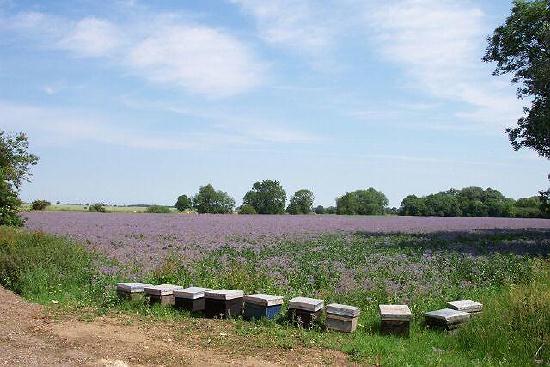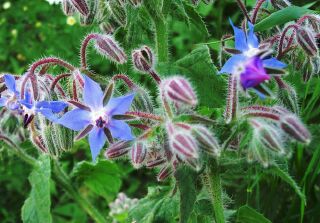|
Borage

Borage growing at Wilsthorpe, near Bourne, in July 2005, with
attendant beehives.
Bees love borage
and if you walk into a field of it in when the crop is in full bloom you
will find them at their busiest. Borage (Borago officinalis) is a
herb with brilliant blue, star-like flowers and greyish-green leaves and
may be seen growing wild during the summer months on banks and in hedges
but it is also cultivated as a commercial crop in some isolated places in
South Lincolnshire.
Borage is a hardy annual plant that originated in Aleppo, Syria, but has
since become naturalised in most parts of Europe and frequently found in
this country, often on rubbish heaps and near dwellings and so may be
regarded as a garden escape because it was for many years grown for the
kitchen, both for its uses as a herb and for the sake of its flowers which
can be candied to decorate confectionery, as well as yielding excellent
honey.
In addition, the young leaves have a faint cucumber flavour and make an
interesting addition to salads or they can be infused to make a refreshing
and restorative summer drink when compounded with lemon and sugar in wine
or water. In the 19th century, it was always an ingredient in cool
tankards of wine and cider and is still used to add flavour to a claret
cup.
The name may be derived from the Latin burra, meaning a shaggy
garment, on account of the rough hairy leaves of the plant.
John Gerard, the famous 16th century herbalist, wrote of borage: “Those of
our time do use the flour in salads, to exhilarate and make the mind glad.
There be also many things made of these used everywhere for the comfort of
the heart, for the driving away of sorrow and increasing joy. The leaves
and flowers of borage put into wine make men and women glad and merry and
drive away all sadness, dullness and melancholy. Syrup made of the flowers
comforts the heart and quiets the frenetic and lunatic person. The leaves
eaten raw engender good blood, especially in those that have been lately
sick.”
|
Blue is a rare colour to see in the
Lincolnshire countryside and borage is therefore often confused with
flax although that is a lighter and more delicate shade. Borage is
also much shorter in stature and the leaves and stems have a
distinctive, hairy nature. In years past, the flowers were used to make a
soothing syrup concoction and when candied provided an attractive
decoration for confectionery although their use today is confined mainly
to the production of honey. |
 |
The diarist John Evelyn also had a few words to say about the comforting
properties of the herb. Writing at the close of the 17th century, he said:
“Sprigs of borage are of known virtue to revive the hypochondriac and
cheer the hard student” while other claims for its rejuvenating properties
suggested that it was successful in treating putrid and pestilential
fevers, snake bites, jaundice, consumption, fainting, itching, ringworm,
inflammation of the eyes, sore throat and rheumatism and useful as a
demulcent, diuretic and emollient and as a poultice for inflammatory
swellings. Borage was much used in France for fevers and pulmonary
complaints and by virtue of its saline constituents in the stem and
leaves, promoted the activity of the kidneys and treated chronic catarrhs.
Today, most of these uses have disappeared and apart from appearing in
some domestic herb gardens, borage is grown for the production of honey. A
few days ago, I found a specially planted crop at Wilsthope, four miles
south of Bourne, where a local bee keeper had moved ten of his portable
hives, each containing flourishing colonies of several thousand bees, to
the field's edge to take advantage of the sudden abundance of nectar
created by the flowers and will no doubt soon be reaping the benefit with
many jars of much sought after Lincolnshire borage honey whose producers
still claim some of the therapeutic benefits of yesteryear.
WRITTEN JULY 2005

Go to:
Main Index Villages
Index
|

